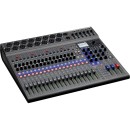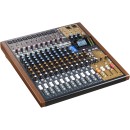TASCAM Model 16 vs Zoom LiveTrak L-20: A Detailed Comparison
The TASCAM Model 16 Hybrid 14-Channel Mixer is a versatile piece of equipment that serves as a mixer, multitrack recorder, and USB audio interface. It integrates analogue warmth with digital precision, making it a great choice for musicians and sound engineers who seek both classic sound and modern functionality. The Model 16 offers 14 input channels with a combination of XLR and quarter-inch inputs, providing flexibility for various audio sources. It also features one-knob compressors on select channels and a built-in effects processor with 16 presets, which adds depth and texture to live performances and recordings. Additionally, the built-in multitrack recorder captures up to 16 tracks directly to an SD card, making it easy to record live sessions without the need for additional equipment.
On the other hand, the Zoom LiveTrak L-20 is a comprehensive digital mixer and multitrack recorder designed for more extensive recording setups. It offers 20 input channels, making it suitable for larger bands and complex audio projects. The L-20 stands out with its ability to mix and record up to 22 tracks simultaneously, and it allows for the creation of up to six custom headphone mixes, which is ideal for live performances or studio environments where multiple musicians need personalized monitor mixes. The Zoom L-20 also includes a range of built-in effects and a user-friendly interface, alongside the capability to function as a 22-in/4-out USB audio interface. This makes it a robust solution for both live and studio applications, offering flexibility and control for detailed audio production.
In summary, while both the TASCAM Model 16 and Zoom LiveTrak L-20 offer multitrack recording and mixing capabilities, they cater to slightly different needs. The TASCAM Model 16 is more compact and might appeal to those who prioritize analogue sound and simplicity in smaller setups. In contrast, the Zoom LiveTrak L-20 is ideal for users who require more channels and advanced mixing options, making it suitable for larger ensembles and more complex recording sessions. Both units deliver high-quality sound and offer the essential features needed for modern music production, but the choice ultimately depends on the scale of the project and specific user requirements.
In the following sections, we will delve into a detailed comparison of the TASCAM Model 16 Hybrid 14-Channel Mixer, Multitrack Recorder, and USB Audio Interface with the Zoom LiveTrak L-20 Digital Mixer. This article thoroughly examines each product's specifications, highlighting their advantages and disadvantages to help you make an informed decision.
Specifications, Pros, and Cons of TASCAM Model 16 and Zoom LiveTrak L-20
| User Rating Based on Analysis of Reviews | |
|---|---|
|
Show More |
| Pros: | |
|---|---|
|
|
| Cons: | |
|---|---|
|
|
| Find Best Price | Find Best Price |
| General |
|---|
| Signal Processing | |
|---|---|
| EQ Parameters | |
| High: ±15 dB at 10 kHz (Shelving) Mid: ±15 dB at 100 Hz to 8 kHz (Semi-Parametric) Low: ±15 dB at 100 Hz (Shelving) |
Mono Channels: High: ±15 dB at 12 kHz (Shelving) Mid: ±15 dB at 100 Hz to 8 kHz, 0.55 Q (Semi-Parametric) Low: ±15 dB at 80 Hz (Shelving) Stereo Channels: High: ±15 dB at 12 kHz Mid: ±15 dB at 600 Hz, 0.55 Q (Notch/Peak) Low: ±15 dB at 80 Hz (Shelving) Master: High: ±15 dB at 10 kHz (Shelving) Mid: ±15 dB at 100 Hz to 8 kHz, 0.5 to 5 Q (Parametric) Low: ±15 dB at 60 Hz (Shelving) |
The TASCAM Model 16 Hybrid 14-Channel Mixer is designed with a more comprehensive gain/trim range compared to the Zoom LiveTrak L-20. The TASCAM offers a mic input gain of up to 79 dB, while the USB and SD inputs provide a gain of 24 dB. Additionally, its XLR mic inputs range from 0 dB to 50 dB and line inputs range from -10 dB to +40 dB on channels 1 to 8, demonstrating a versatile range for various audio sources. In contrast, the Zoom LiveTrak L-20 features a standard 3-band EQ, with a high frequency boost of ±15 dB at 10 kHz and a mid frequency adjustment of ±15 dB at 100 Hz to 8 kHz.Show More
When it comes to equalization, the TASCAM Model 16 presents a more advanced setup with its semi-parametric mid EQ on mono channels allowing for greater control over frequencies between 100 Hz to 8 kHz. This mixer also provides a high-pass filter at 100 Hz with an 18 dB/octave slope, offering additional options for shaping the sound. On the other hand, the Zoom LiveTrak L-20 simplifies the EQ process with its 3-band EQ, which limits its flexibility but still provides essential tonal control.
In terms of dynamic processing, the Zoom LiveTrak L-20 includes a built-in compressor on mono channels, which can help manage audio levels and dynamics during recording and mixing. This feature is absent in the TASCAM Model 16, which, however, compensates with its more detailed EQ parameters across its channels. The TASCAM also supports built-in effects to a lesser extent, while the Zoom mixer boasts 20 types of unspecified effects, enhancing its usability for live performances.
Both interfaces serve their purpose but cater to different needs. The TASCAM Model 16 is ideal for users seeking extensive control over audio mixing and processing with its broad gain range and advanced EQ capabilities. Meanwhile, the Zoom LiveTrak L-20 offers a more straightforward approach with dynamic processing and built-in effects, making it suitable for those looking for simplicity along with multitrack recording capabilities.
| Connectivity | |
|---|---|
| Wireless | |
| Bluetooth *Via Optional Adapter |
Bluetooth |
The TASCAM Model 16 Hybrid 14-Channel Mixer features an extensive analog audio I/O configuration, with 10 XLR 3-Pin Balanced Mic Inputs, 12 1/4" TRS Balanced Line Inputs, and various other inputs including a Stereo RCA Coaxial Unbalanced Line Input and a 1/8" / 3.5 mm TRS Unbalanced Stereo Output. This makes it a versatile option for various audio sources. Additionally, it provides multiple outputs such as 2 XLR Balanced Main Outputs, 3 1/4" TRS Balanced Aux Outputs, and 2 1/4" TRS Balanced Subgroup/Bus Outputs, catering to complex mixing needs.Show More
In contrast, the Zoom LiveTrak L-20 Digital Mixer offers a more streamlined approach with a focus on digital recording capabilities. Although specific I/O details are not provided, it is designed for live performances and recording with an emphasis on portability and ease of use. The L-20 allows for multitrack recording directly onto an SD card, which is a significant advantage for users looking for quick setups during live events.
Both mixers support Bluetooth connectivity, though the TASCAM Model 16 includes this feature natively, while the Zoom LiveTrak L-20 requires an optional adapter for wireless functionality. The TASCAM also boasts 48 V phantom power for condenser microphones, enhancing its usability for studio and live applications. This feature may offer an edge to the TASCAM Model 16 for users who frequently work with professional-grade microphones.
In terms of host connection, the TASCAM Model 16 utilizes a USB-B connection with USB 2.0 protocol, making it compatible with a wide range of computers and DAWs. The Zoom LiveTrak L-20, while not specified, is designed for straightforward integration into digital workflows, particularly catering to those who prioritize ease of recording and mixing in live settings.
| Performance | |
|---|---|
| Headphone Output Power | |
| 10 mW per Channel into 60 Ohms (Max) | 10 mW per Channel into 60 Ohms (Max) |
The TASCAM Model 16 Hybrid is a 14-channel mixer that offers a robust frequency response of 20 Hz to 30 kHz in its analog mode and 20 Hz to 20 kHz in digital mode, providing high-quality audio fidelity. In terms of input levels, it features various connectors with maximum input levels such as +10 dBu for XLR mic inputs and +22 dBu for 1/4" line inputs. The maximum output level is also noteworthy, with main outputs reaching +22 dBu and control room outputs at +16 dBu, ensuring strong signal levels.Show More
On the other hand, the Zoom LiveTrak L-20 is a digital mixer that also provides multitrack recording capabilities. While specific frequency response data is not detailed, it is designed for high-quality audio mixing and recording. Similar to the TASCAM, the headphone output power is rated at 10 mW per channel into 60 Ohms, which ensures adequate monitoring capabilities.
When comparing the two, the TASCAM Model 16 stands out with its comprehensive range of input levels and outputs, particularly its high maximum input and output levels. It also offers additional specifications such as total harmonic distortion (THD) lower than 0.01% for mic inputs, showcasing its capability for clean audio reproduction. In contrast, the Zoom LiveTrak L-20 is more focused on the digital aspect of mixing and recording, although it lacks some detailed specifications found in the TASCAM model.
| Compatibility |
|---|
| Power |
|---|
| Packaging Info | |
|---|---|
| Package Weight | |
| 11.4 lb | 22.135 lb |
| Box Dimensions (LxWxH) | |
| 21.2 x 18 x 5.8" | 23 x 20 x 8.8" |
The TASCAM Model 16 is a hybrid 14-channel mixer that combines a multitrack recorder and USB audio interface, making it a versatile tool for both live sound and studio recordings. It has a package weight of 22.135 lb and dimensions of 23 x 20 x 8.8". This heftier design is likely due to its robust build and the inclusion of various features that cater to professional audio applications. The extra weight can suggest a sturdier construction, which may be beneficial for frequent transport or live performances.Show More
In contrast, the Zoom LiveTrak L-20 is a digital mixer that also functions as a multitrack recorder, but is more lightweight, with a package weight of 11.4 lb and dimensions of 21.2 x 18 x 5.8". The compact design makes it easier to transport, appealing to musicians and audio engineers who need portability without sacrificing functionality. Despite its smaller size, the L-20 still offers a range of features designed for professional use, which may attract users who prioritize convenience during live setups.
Both products serve similar purposes in the realm of audio mixing and recording, yet their physical characteristics differ significantly. The TASCAM Model 16's larger weight and dimensions may indicate a more feature-rich environment, potentially offering more channels and connectivity options. Meanwhile, the Zoom LiveTrak L-20, with its lighter build and smaller footprint, is engineered for ease of use on the go, making it a great choice for those who prioritize mobility alongside functionality.
| Customer Images | |
|---|---|
|
|
|
| Videos | |
|---|---|
|
|
|





